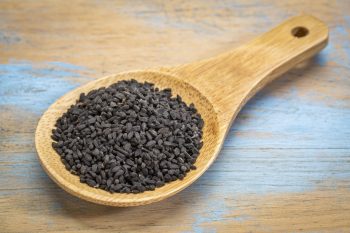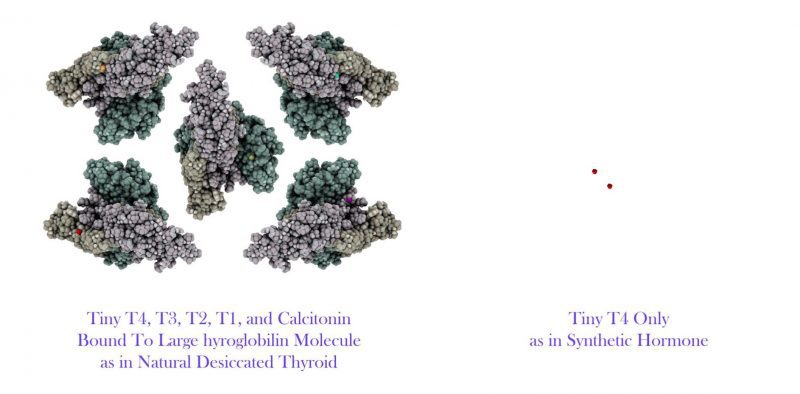 By Sayer Ji
By Sayer Ji
Contributing writer for Wake Up World
A recent clinical trial indicates that Hashimoto’s disease, the most common form of hypothyrodism, may be improved by adding only two grams of powdered black seed to your daily diet.
A powerful new randomized clinical trial reveals that the ancient healing food known as nigella sativa (aka “black seed”), once known as the “remedy for everything but death”, may provide an ideal treatment for the autoimmune thyroid condition known as Hashimoto’s disease, which is the most common cause of hypothyroidism.
The new study, published in the journal BMC Complementary and Alternative Medicine, evaluated the effects of nigella sativa on patients with Hashimoto’s thyroiditis, and in particular, assessed thyroid function, serum Vascular Endothelial Growth Factor (VEGF) – 1, Nesfatin -1 and anthropometric features using a randomized controlled trial
[pro_ad_display_adzone id=”110028″]
The study took 40 patients with Hashimoto’s thyroiditis, aged between 22 and 50 years old, and randomized them into one group receiving two grams of powdered encapsulated Nigella sativa and the other 2 grams starch placebo daily for 8 weeks. Changes in anthropometric variables, dietary intakes, thyroid status, serum VEGF and Nesfatin-1 concentrations were measured.
The positive results were reported as follows:
“Treatment with Nigella sativa significantly reduced body weight and body mass index (BMI). Serum concentrations of thyroid stimulating hormone (TSH) and anti-thyroid peroxidase (anti-TPO) antibodies decreased while serum T3 concentrations increased in Nigella sativa-treated group after 8 weeks. There was a significant reduction in serum VEGF concentrations in intervention group. None of these changes had been observed in placebo treated group. In stepwise multiple regression model, changes in waist to hip ratio (WHR) and thyroid hormones were significant predictors of changes in serum VEGF and Nesgfatin-1 values in Nigella sativa treated group (P?<?0.05).”
The researchers concluded:
“Our data showed a potent beneficial effect of powdered Nigella sativa in improving thyroid status and anthropometric variables in patients with Hashimoto’s thyroiditis. Moreover, Nigella sativa significantly reduced serum VEGF concentrations in these patients. Considering observed health- promoting effect of this medicinal plant in ameliorating the disease severity, it can be regarded as a useful therapeutic approach in management of Hashimoto’s thyroiditis.”
What is Hashimoto’s Disease and Why Does Synthetic T4 Fail To Improve Well-Being?
Hashimoto’s disease can be a devastating condition, especially when treated with a conventional medical approach. Also known as chronic lymphocytic thyroiditis, it is a progressive autoimmune disease where, in the many cases, the thyroid gland is eventually destroyed. It is considered the most common cause of hypothyroidism in North America. Some additional salient facts are:
-
It is estimated that about 5% of the U.S. population will be affected by Hashimoto’s thyroiditis at some point in their life.
-
Hashimoto’s occurs up to 15 times more often in women than in men. The highest density of Hashimoto’s cases are between 30 and 60 years of age.
-
Postpartum thyroiditis occurs in about 10% of patients.
-
Hashimoto’s related hypothyroid is often under-diagnosed because the reference ranges were drawn from an unscreened population likely inclusive of those already suffering from suboptimal thyroid function or outright dysfunction.
[pro_ad_display_adzone id=”110030″]
The standard of care is to ‘manage’ symptoms — to artificially suppress, modulate, and/or replace hormone levels. Hypothyroidism caused by Hashimoto’s thyroiditis is most commonly treated with the synthetic T4 hormone, in an attempt to reduce TSH levels under 5.0 U/ml. This often results in the appearance of TSH normalization, with downstream adverse effects, and without concomitant improvements in well-being. Dr. Kelly Brogan, MD, further elaborates:
“For those who do receive the label of hypothyroid, they remain obliquely objectified by their lab work as their doctors use synthetic T4 – Synthroid – to attempt to move their TSH within range, more often leaving them symptomatic but “treated” because of poor conversion to active thyroid hormone (T3) and suppression of natural T3 production because of their now lower TSH.”
It should be noted that while synthetic T4 is described by its manufacturer to be “identical to that produced in the human thyroid gland”, it is in actuality quite different. This has to do primarily with the fact that while the primary structure of amino acids in synthetic thyroxine produced from genetically modified yeast is virtually identical to that produced by the human thyroid gland, the secondary, tertiary and quaternary folding patterns of that protein may differ in significant ways. Known as the protein’s conformational state, a slight change in folding structure can profoundly alter function. This could account for widespread reports of dissatisfaction among those treated with the synthetic thyroid hormone versus natural forms (eg. those extracted from the glands of pigs.)
Even if the T4 produced synthetically were identical in structure and function to natural T4, the reality is that virtually all T4 found naturally in the human body is not found in its free state. Moreover, T4 is found inextricably bound together with T3, T2, T1, and calcitron, in the extraordinarily complex Thyroxine Binding Globulin (TBG) protein. Clearly, therefore, pharmaceutical preparations of isolated T4 can not be considered identical to whole-food complexed thyroid hormones derived from natural extracts.
In a post titled, “Natural Desiccated Thyroid and Synthetic are NOT the Same,” from thyroid-s.com, this point is driven home powerfully:
“To graphically illustrate the huge differences between Natural Desiccated Thyroid as compared to T4 Only Synthetics, please consider this graphic. [Below] It attempts to show the tiny T4, T3, T2, T1 and Calcitonin hormones tightly bound to the very large thyroglobulin molecules as found in Natural Desiccated Thyroid. Remember that the Thyroglobulin molecule is approximately 1,000 TIMES BIGGER than the T4 molecule. Then it also shows the tiny T4 molecules as found in synthetic T4 only products. The pharmaceutical companies would have us believe these are bio-identical. We will let you decide.”
Moreover, research published in 2010 in the Archives of Pharmaceutical Research shows that levothyroxine preparations are widely contaminated with a “mirror image” stereoismer called dextro-thyroxine at a level as high as 1-6% by dry weight. D-thyroxine violates the left-handed ‘chirality’ of natural thyroxine and is a powerful, cardiotoxic endocrine disruptor.
The process by which levothyroxine sodium is produced today is highly synthetic and involves the use of a wide range of chemicals. One patent describes the dizzyingly complex process as follows:
“The process for preparation of Levothyroxine sodium comprises the steps, wherein compound obtained from steps a-g is prepared by conventional methods, a. nitrating L-tyrosine to give 3,5- dinitro-L-tyrosine, b. acetylating 3,5- dinitro-L-tyrosine to give 3,5- dinitro-N-acetyl L-tyrosine, c. esterifying the compound obtained from step (b) to give 3,5- di?itro-N-acetyl L-tyrosine ethyl ester, d. reacting the compound obtained from step (c) with p-TsCI in presence of pyridine to give corresponding tosylate salt, which is further reacting with 4-methoxy phenol to give 3,5- DinKro-4-p-methoxy phenoxy-N-acetyl-L-phenyl alanine ethyl ester, e. the compound obtained from step (d) is hydrogenated to give 3,5-diamino-4-p-methoxy phenoxy-N-acetyl-L-phenyl alanine ethyl ester, f. the compound obtained from step (e) is tetrazotized and iodized to give 3,5-Diiodo-4-p- methoxy phenoxy-N-acetyl-L-phenyl alanine ethyl ester, g. the compound obtained from step (f) is O-demethylated, N-deacetylated, and deesterified using aqueous HI in acetic acid to give 3,5-Diiodo-4-p-hydroxy phenoxy-L-phe?yl alanine followed by preparing hydrochloride salt of same and isolating, drying it h. lodinating 3,5-Diiodo-4-p-hydroxy phe?oxy-L-phenyl alanine HCI salt using methyl amine,”
Clearly, synthetic T4 treatments, even if effective at suppressing TSH, may not produce clinical outcomes that translate into improvement in well-being. Nor do they address or resolve the root causes of Hashimoto’s, which include selenium deficiency, wheat intolerance, and vitamin D/sunlight deficiency [view studies on these links on GreenMedInfo’s Hashimoto’s research dashboard], along with a wide range of still yet unknown environmental, dietary, lifestyle, and mind-body factors. Perhaps this latest study on black seed provides a new avenue for mitigating and correcting the metabolic and endocrine factors that are disturbed in Hashimoto’s disease, or at least complementing conventional treatment with a food-based approach that can improve both the subjective and objective aspects of the disease.
For more information on natural and integrative approaches to thyroid disease visit the following resource pages on GreenMedInfo.com:
To learn more about the powerful health benefits of black seed, visit GreenMedInfo’s research dashboard on the subject: Nigella Sativa (aka Black Seed)
About the author:
Sayer Ji is the founder of Greenmedinfo.com, a reviewer at the International Journal of Human Nutrition and Functional Medicine, Co-founder and CEO of Systome Biomed, Vice Chairman of the Board of the National Health Federation, and Steering Committee Member of the Global Non-GMO Foundation.
For more, visit GreenMedInfo.com and Facebook.com/GreenMedInfo, or sign up for GreenMedInfo’s free e-Newsletter.
Recommended articles by Sayer Ji:
- Wi-Fi Devices Increase Mercury Release From Dental Amalgams
- Black Seed Oil Puts Deadly Asthma Medications to Shame
- Participating in Drum Circles Improves Health and Quality of Life in Parkinson’s Patients (Study)
- Acupuncture Beats Injected Morphine for Pain: Groundbreaking Study
- Mammography Is Harmful and Should Be Abandoned, Scientific Review Concludes
- “Killer Germs” Obliterated by Medicinal Smoke Smudging, Study Reveals
- 6 Evidence-Based Ways Drumming Heals Body, Mind and Soul
- Turmeric’s ‘Smart Kill’ Properties Put Chemo & Radiation To Shame
- Beet Juice Boosts Cognitive Function In One Dose
- 13 Evidence-Based Medicinal Properties of Coconut Oil
- Group Drumming Better Than Prozac, Study Suggests
- 25 Cancer Stem-Cell Killing Foods That Are Smarter Than Chemo and Radiation
- Splenda Suppresses Thyroid Function, Promotes Weight Gain
[pro_ad_display_adzone id=”110027″]








